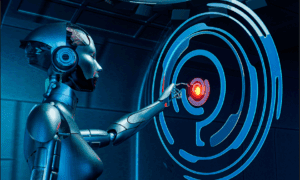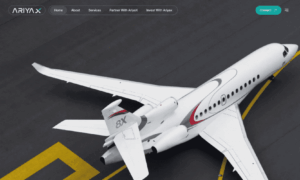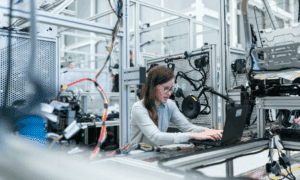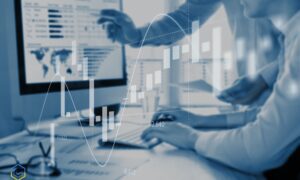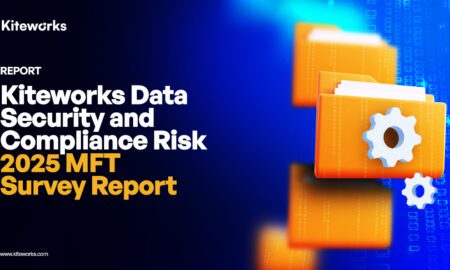Understanding the Difference Between ToF and LiDAR
Although both are used for depth sensing, it is important to note that Time of Flight (ToF) cameras work differently from Light Detection and Ranging (LiDAR) technology. A ToF camera measures depth by determining the time it takes for light pulses to hit an object and reflect to the sensor. Conversely, LiDAR scans the environment as beams of laser light, utilizing the time it takes for reflected light waves to return to make distance measurements. Hence, although LiDAR achieves superior precision in outdoor scenarios, ToF cameras are more practical for fast and affordable 3D reconstruction for indoor and consumer applications.
How Does a Time of Flight Camera Work?
A time-of-flight camera is based on measuring the time taken for infrared light pulses to travel to an object and reflect to the sensor. Using this time measurement along with the speed of light, the camera calculates the precise distances of objects in its field of view. ToF cameras use three primary techniques: direct ToF, indirect ToF, and continuous-wave ToF. These techniques allow them to achieve high-precision depth perception, so ToF cameras are widely used in a variety of fields such as robotics, augmented reality, and homeland security systems.
The Effective Range of a Time of Flight Camera
Factors like its infrared light source power, sensor sensitivity, or environmental conditions determine the range of a time-of-flight camera. Note: The consumer-grade ToF (Time of flight/motion) camera (the application) typically has a range of 0.1~5m, and is used in face recognition, gesture tracking, etc. Automotive and industrial ToF cameras can work from a few centimeters to up to 100 meters.
Role of Time of Flight in Computer Vision
Posted on October 22, 2023by Having data up to October 2023 Train the camera in computer vision of us to know that a camera is a tool that captures light. These cameras improve machine learning models by capturing accurate 3D spatial information that is crucial for robotics, AR, and VR applications. In robotics, ToF cameras help robots navigate environments in real time by identifying obstacles. They enhance spatial awareness in AR and VR, enabling users to engage with digital content more intuitively.
Enhancing Augmented and Virtual Reality Experiences
Augmented Reality Solutions with Time-of-Flight Cameras One of the most promising applications of time-of-flight cameras is augmented and virtual realities. These cameras enhance the accuracy in depth perception, facilitating life-like interactions between virtual elements and the physical world. The use of ToF tech is also crucial, which enables AR MIRA devices to scan their surroundings in real time, improving capabilities such as object placement, gesture recognition, and immersiveness. To deliver a smooth AR and VR experience, major tech companies build ToF cameras into smartphones, and headsets.
Improving Smartphone Camera and Photography
Many modern smartphones now come with time-of-flight cameras, which serve to improve their cameras. ToF sensors help with portrait mode photography, delivering improved background blur and depth-of-field effects. They also facilitate better low-light photography by helping autofocus perform even faster and more accurately. Moreover, ToF cameras are compatible with gesture control, enabling users to control their devices with gestures without touching the screen. It is the most common imaging technology used in premium smartphones for best quality.
Increasing Accuracy in Facial Recognition Technology
Time-of-flight cameras are very useful for facial recognition systems, as they allow a very accurate depth map to be captured. Though conventional 2D-based facial recognition has been in existence, Time-of-flight technology (ToF), which provides a 3D facial model, is much more secure and prevents spoofing attacks using photos or videos, as we discussed before. You are served on data So in the biometric security systems incorporating advanced depth-sensing technology, providing better identity authentication for smartphones, smart locks, and access control systems.
Optimizing Autonomous Vehicles and Driver Assistance
In automotive, as the world moves towards autonomous vehicles and advanced driver assistance systems (ADAS), time-of-flight cameras are also playing an important role. Together with another important sensor, these cameras file depth in real-time offering a strong help to vehicles when detecting obstacles, pedestrians or other objects while on their way. Time-of-flight technology is also used to improve driver monitoring systems by monitoring head positioning and eye position keeping an eye on driver alertness. This can help fight towards safer roads, as well as build towards self-driving technology.
Revolutionizing Industrial Automation and Robotics
Time-of-flight cameras are utilized in industrial automation to accurately identify objects, guide robotic arms, and automate warehouses. These cameras can capture the real-time depth allowing industrial robots to perform a wide range of tasks including picking and placing objects, quality inspection, and autonomous navigation. To facilitate these manufacturing and logistics operations in smart factories, ToF technology is used extensively.
Enhancing Security and Surveillance Systems
Time-of-flight cameras enable accurate motion detection and intruder identification in security and surveillance applications. ToF sensors are best known for their ability to operate in darkness and through fog, unlike traditional cameras, which capture imagery across a 2-D surface, meaning depth data is not available. The 3D nature of ToF sensors makes them extremely effective for localization, which requires knowing where objects are in space before they become too close. Smart cameras are built into smart security systems that allow for advanced monitoring of homes, businesses, and public locations. This means that ToF cameras can be an integral part of modern surveillance technology to capture motion detection and human behavior.
Supporting Medical Imaging and Healthcare Solutions
Time-of-flight cameras are gaining traction in the healthcare industry for uses in medical imaging, patient monitoring, and physical therapy. 3D body scanning is done using these cameras for accurate diagnostics and treatment planning. ToF technology assists patient tracking in rehabilitation to monitor the movements of patients undergoing physical therapy while providing real-time feedback for optimal recovery. As a result, the non-invasive nature of ToF cameras makes them suitable for different medical and diagnostic applications.
Advancing Gesture Control and Human Interaction
Gesture control technology has undergone a significant transformation through ToF cameras, which enable users to control devices merely using their hands and body movements. Its application is most prevalent in gaming consoles, smart TVs, and interactive kiosks. Ts,… touchless interaction for consumer electronics and public building interfaces through reliable motion tracking is made easy through ToF cameras. ToF technology-based gesture recognition is emerging in the field of smart home automation.
Conclusion
The fast pace of time-of-flight camera technology improvements fuels innovation in a wide variety of sectors including mobile, automotive, industrial automation, and health care. ToF cameras are revolutionizing computer vision, augmenting reality, security, and robotics with their ability to deliver accurate depth sense and real-time 3D mapping. As technology develops, ToF camera use cases will only continue to broaden, leading to even more intelligent and efficient solutions in the tech of today.
For more information about the time of flight camera technology, visit Goermicro.


